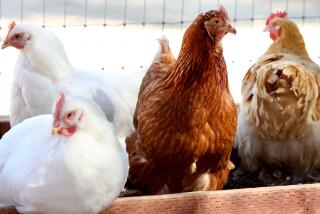Policies Governing Research Animals’ Care Strengthened
- Share via
Guidelines were unveiled here Thursday strengthening the accountability for the care and use of laboratory animals involved in medical research at about 800 facilities across the nation.
Released by a division of the National Institutes of Health at a workshop at the USC School of Medicine, the new government policy is aimed at persuading the public that animal research is being conducted in a humane manner, said Charles McCarthy, director of the Office for Protection from Research Risks.
The guidelines were proposed a year ago after some congressmen expressed skepticism about whether the older guidelines were working. A series of laboratory break-ins conducted by animal rights groups brought the issue to public attention.
Public Hearings
Since then, according to McCarthy, his office has incorporated into the guidelines the suggestions of a wide variety of individuals and animal rights organizations who appeared at three public hearings last summer in Boston, Kansas City and Seattle.
Key features of the new guidelines are the creation of animal care and use committees at every facility that gets Public Health Service funding and the requirement that each research project involving animals receives the committee’s approval before the federal government will finance it.
The committees’ function will be to ensure that research animals are handled in compliance with guidelines on appropriate use of the animals, McCarthy said. Previously such committees were voluntary.
The guidelines also require that a senior official at each institution make certain that the committee does its assigned job and hold that official responsible if it does not, McCarthy said.
Detailed Record Keeping
The Public Health Service has the authority to halt any research that it funds in which there are serious infractions of the guidelines, he said. The Public Health Service finances most biomedical research in the United States, including all grants awarded by the National Institutes of Health.
Other aspects of the new policy deal with improved ventilation, larger cages and requirements for more detailed record keeping. Details of the changes were not disclosed Thursday, and McCarthy said the complete guidelines will be published by the National Institutes of Health in about three weeks.
“When the moderate animal rights groups learn of the new guidelines, they will be pleased,” McCarthy said in an interview. “We are hoping that some individuals who associate with radical groups will shift to a more moderate group. But I’m afraid that anyone who wants to break into a lab won’t be dissuaded by our policy.”
A spokeswoman for The Animal Liberation Front and People for the Ethical Treatment of Animals, two of the nation’s most radical animal rights groups, told The Times in a telephone interview that her organizations “are very pleased with the acceptance of the new guidelines.”
“Part of the reason people resort to drastic measures is because of frustration with the lack of progress through legitimate channels,” said Holly Jensen, a nurse in Gainesville, Fla.
Asked how this reaction might affect future animal laboratory break-ins, she said that her opinion is that the guidelines “will give people in the ALF cause to consider whether drastic measures are still appropriate.
“Each individual member has his or her own opinion. We want to work through whatever channels work.”
Jensen said that the tapes and records that have been confiscated during laboratory raids “have been essential in convincing NIH and the public at large” that existing rules have not been strictly enforced.
Told later in the day of Jensen’s comments, McCarthy said that although the main purpose of the guidelines is to affect the behavior of investigators rather than that of outsiders, he welcomes any effect the new policy may have on others. McCarthy said that raids at animal research laboratories and charges of inhumane treatment of animals by “radical” animal rights groups have seriously undermined public confidence that laboratory animals are receiving good care.
Careful Work Wanted
“The press has given undue attention to radical groups, causing the public to be unaware that a large number of organizations exist that are not opposed to animal research but that want it done carefully,” he said.
McCarthy said his office, based in Bethesda, Md., investigated about 14 institutions last year at which serious violations of standards had been reported. Of these, eight or nine proved to be unfounded, he said.
In drawing up the guidelines, McCarthy said, his office could not honor either of the two extreme viewpoints voiced last summer at the public hearings. At the opposite end of the spectrum from those who believe that animals should never be used for research, he said, was a small group of researchers who believe that the federal government should not set any standards.
The federal government is mandated by law to use animals for the prevention, diagnosis and treatment of all human diseases if other methods, such as computer models or suitable tissue cultures, are not available, he said.
In fact, he said, federal law prohibits researchers from doing certain procedures on humans for the first time if a suitable animal can be found.
“If we have good standards, the public can see for itself that you are caring for animals in appropriate ways,” McCarthy told the audience of investigators and others concerned with animal research who came from 12 states to attend the USC workshop.
Times staff writer Eric Malnic contributed to this article.
More to Read
Sign up for Essential California
The most important California stories and recommendations in your inbox every morning.
You may occasionally receive promotional content from the Los Angeles Times.













